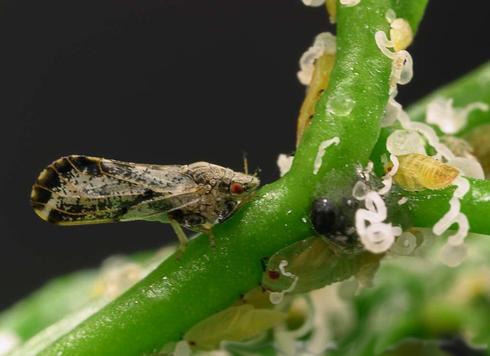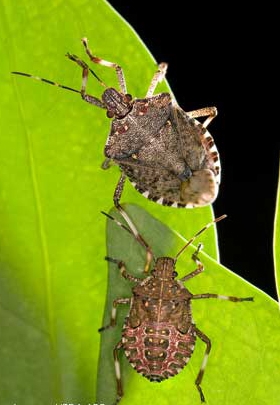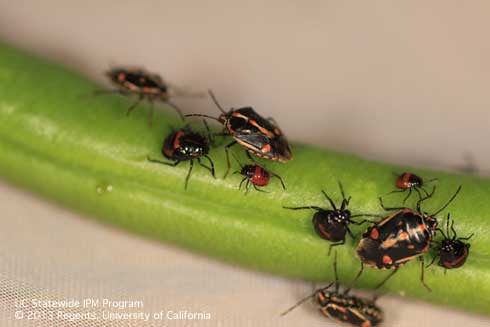Every year, California receives, on average, six new exotic invasive pests of concern; that's about one new pest every 60 days. These may be plants, insects or other arthropods, mollusks, plant pathogens such as fungi and bacteria, vertebrates, or any other organism not native to our state and with the capacity to negatively impact agriculture, urban environments and/or natural ecosystems. These invasive pests enter California on plant material and other biological substrates, as hitchhikers on trade goods and in ship ballast water, and sometimes even because of smuggling operations. Without the natural enemies that kept them in check in their native lands, they are free to reproduce and wreak havoc. Such pest invasions may then lead to destruction or alteration of habitat, loss of agricultural trade revenues, pronounced losses in agricultural production, and increases in pesticide applications.
The best way to combat such invasions may be through robust exclusion, inspection, early detection, and quarantine programs. Once established, they are best managed using classical and conservation biological control and the decision-making process of integrated pest management (IPM), described in detail in an earlier blog post. Urban agricultural environments are not immune to these invasions and may even be more at risk since urban environments contain many likely routes of introduction and have often been identified as point sources for invasive pests. In this article we will review the biology, ecology, and management of three recent pests that may increasingly be found in urban gardens and other urban ag environments.
Asian citrus psyllid and the huanglongbing pathogen: First found in Southern California in 2008, the Asian citrus psyllid (ACP), Diaphorina citri, feeds on citrus and related plants in the Rutaceae family, sucking sap and injecting toxins that distort new growth. Even worse, however, the psyllids can transmit an incurable citrus disease, huanglongbing (HLB) or citrus greening, from plant to plant. Currently, the psyllid's distribution is limited to urban Southern California and small parts of the citrus production areas in the San Joaquin Valley. The bacterial disease HLB is thankfully not established in California, but it has been detected (and eradicated) in urban Los Angeles County and intercepted recently at a port-of-entry in San Mateo County. If you grow citrus, make sure to check new growth during spring and fall to look for psyllid nymphs and the distinctive waxy tubules they excrete. Report any suspect finds to your County Agricultural Commissioner's office. Make sure to comply with the management tactics prescribed by these authorities; trees across the state depend on it. To learn more about ACP, HLB, management tactics, and other related topics please visit the following links:
PESTNOTES - UC IPM Online: Asian Citrus Psyllid and Huanglongbing Disease
Center for Invasive Species Research: Asian Citrus Psyllid
UC scientists release a natural enemy of Asian citrus psyllid
Brown marmorated stink bug (BMSB): This large (5/8”) stink bug from eastern Asia has been an established pest in the eastern United States since 2001. Though it has been intercepted many times in California over the years, probably because of its ability to hitchhike on and in outdoor household items (such as patio furniture) and firewood, it has only recently (sometime between 2006 and 2013) become established in the state. The BMSB, Halyomorpha halys, is a key agricultural pest, reportedly attacking over 100 plant species using piercing mouthparts to suck juices and inject tissue-damaging enzymes. Damage is expected to be worst on pome fruits (apples, pears), stone fruits (peaches, nectarines), legumes, corn, tomatoes, and peppers. Stink bugs are known to aggregate in large numbers in fall, sometimes entering homes and other structures to escape harsh winter conditions. BMSB can be distinguished from several native stink bug species by two white bands on the antennae. The current distribution in California is unknown, so if you think you find BMSB you should contact your County Agricultural Commissioner's office to confirm and document its presence. To learn about BMSB identification and management, please visit the following links:
PEST NOTES - UC IPM Online: Brown Marmorated Stink Bug
Pest Alert - UC IPM Online: Brown Marmorated Stink Bug
Center for Invasive Species Research: Brown Marmorated Stink Bug
Bagrada bug: This small (1/4”) relative of the BMSB, also called the painted bug, preferentially attacks many plants in the mustard family (Brassicaceae), including crops such as broccoli, Brussels sprouts, cabbage, and kale, as well as related ornamental plants such as sweet alyssum, stock, and candytuft. Native to Africa, bagrada bug was first found in urban southern California in 2008 and has been slowly moving up the coast and north within the Central Valley. Most recently, the pests has become established within many urban gardens in the San Francisco Bay Area and in small farms in the Capay Valley. Damage is most severe on newly-planted seedlings; stunting and death are common when infestations are large. The brightly-colored (orange, black, and white) bugs are sometimes confused with the similarly-colored harlequin bug, a common American species, though these are three times larger and lack any white coloration. Similar to the BMSB, bagrada bugs may aggregate and enter structures and other protected areas during winter. As with the other invasive pests discussed, if you think you find bagrada bug in your area, then please alert your County Agricultural Commissioner's office, especially in areas where these insects have yet to be found. To learn more about bagrada bug identification and management, please visit the following links:
PEST NOTES - UC IPM Online: Bagrada Bug
Pest Alert - UC IPM Online: Bagrada Bug
Center for Invasive Species Research: Bagrada Bug


